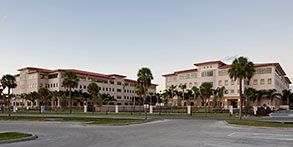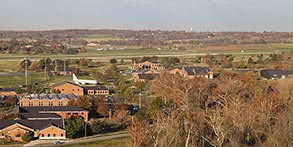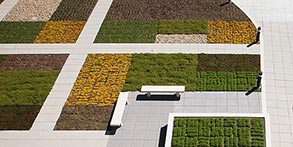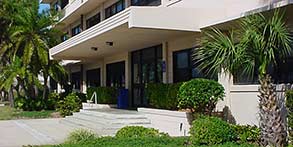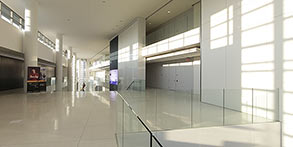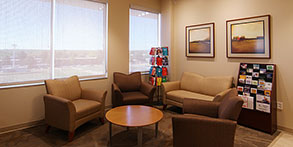Air Force Corporate Standards
Design and construct all buildings in compliance with the Federal High Performance and Sustainable Buildings (HPSB). Requirements as detailed in UFC 1-200-02. Reduce the total cost of facility ownership through sustainable design features such as a building’s orientation, thermal envelope and shading devices. Address climate resiliency and local and regional contexts in building designs and features. Incorporate all natural and passive strategies that are life cycle cost effective, before designing active and mechanical sysytems. Maintain occupant health, safety and wellness while satisfying mission and user requirements. Use products and materials that have a lesser or reduced negative impact on human health and the environment.
Follow federal requirements to reduce demand and optimize performance of the building energy and water systems as a key strategy to minimizing the total ownership cost of AF facilities. Design buildings to achieve at least 30% energy consumption reduction from the ASHRAE 90.1 baseline. Base design decisions on life cycle cost (LCC) effectiveness using calculation methodologies detailed in NIST Handbook 135.
Mitigate heat island effect in the design and selection of materials for roofing, walls, pavement and other hardscape materials, and integrate these with stormwater management practices when appropriate following UFC 3-210-10. When upgrading lighting systems to achieve efficiency metrics, reduce light pollution as detailed by UFC 3-530-01.
Design facilities for maximum efficiency given their climate zone. Integrate passive heating and cooling systems prior to the design of active mechanical systems. Passive (non-mechanical) thermal comfort methods are allowed and encouraged for ventilation and thermal comfort for facility occupants.
Incorporate life-cycle cost-effective commission activities, solar shading, passive solar heating, radiant heating and cooling, energy recovery, district heating and cooling, ground source heat pumps, and on-site renewable energy systems. When renewable energy generation is not currently life cycle cost effective, the building should be designed and constructed to be renewable energy ready.
Protect and conserve water resources in facility designs to include plumbing fixture efficiency.
Promote practices that reduce, reuse and recycle material and specify reclaimed and recycled materials in construction projects.
Maximize connectivity between indoor and outdoor space when appropriate and maintain an indoor environment which is free of smoke, allergens and harmful chemicals. When practical and cost effective following Life-Cycle Cost Analyses (LCCA) provide daylighting and external views to occupied personnel spaces; include lighting controls following UFC 3-530-01.
Establish and implement a moisture-control strategy to prevent building damage, minimize mold contamination and reduce health risks. Specify materials and products with low pollutant emissions (VOC), including composite wood products, adhesives, sealants, interior paints and finishes, carpet systems, and furnishings. Efficiently use natural and material resources in facility design; consider the use of reclaimed and bio-based materials and materials with recycled content in construction projects.
Provide convenient unobtrusive locations for recycle centers/activities that preserve indoor environmental quality and are integrated with interiors.
Address climate resiliency and local and regional contexts in building designs and features while preserving indoor environmental quality. Refer to section 05. Resilience.
Relationship between Sustainability and Resilience
Coordinate sustainable design with climate and energy resiliency while responding to local and regional contexts in building designs and features. Optimize the complementary aspects between sustainability and resilience to satisfy mission assurance.
Resolve conflicting aspects between sustainability and resilience to satisfy mission assurance. Target a balance of economic, ecological and social considerations.
UFC 1-200-01 General Building Requirements https://www.wbdg.org/dod/ufc/ufc-1-200-01
UFC 1-200-02 High Performance and Sustainable Building Requirements https://www.wbdg.org/dod/ufc/ufc-1-200-02
UFC 3-101-01 Architecture https://www.wbdg.org/dod/ufc/ufc-3-101-01
UFC 3-120-10 Interior Design https://www.wbdg.org/dod/ufc/ufc-3-120-10
UFC 3-210-10 Low Impact Development https://www.wbdg.org/dod/ufc/ufc-3-210-10
UFC 3-410-01 Heating, Ventilating, and Air Conditioning Systems https://www.wbdg.org/dod/ufc/ufc-3-410-01
UFC 3-530-01 Design: Interior and Exterior Lighting and Controls https://www.wbdg.org/dod/ufc/ufc-3-530-01
Air Force Sustainable Design and Development (SDD) Implementing Guidance Memorandum https://www.wbdg.org/FFC/AF/POLICY/af_sdd_impl_guidance.pdf
10 CFR 433 https://www.wbdg.org/ffc/fed/code-federal-regulations/10-cfr-part-433
10 CFR 436 https://www.wbdg.org/ffc/fed/code-federal-regulations/10-cfr-part-436
NIST Handbook 135 http://www.wbdg.org/FFC/NIST/hdbk_135.pdf
US Air Force Family Housing Design Guide for Planning, Programming, Design, and Construction https://www.wbdg.org/FFC/AF/AFDG/familyhousing.pdf

